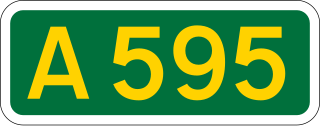
The A595 is a primary route in Cumbria, in Northern England that starts in Carlisle, passes through Whitehaven and goes close to Workington, Cockermouth and Wigton. It passes Sellafield and Ravenglass before ending at the Dalton-in-Furness by-pass, in southern Cumbria, where it joins the A590 trunk road. The road is mostly single carriageway, apart from in central Carlisle, where it passes the castle as a busy dual carriageway road named Castle Way, and prior to that as Bridge Street and Church Street, where it passes close to the McVitie's or Carr's biscuit factory. The Lillyhall bypass is also dual carriageway.

Egremont is a market town, civil parish and two electoral wards in Cumbria, England, and historically part of Cumberland. It is situated just outside the Lake District National Park, five miles south of Whitehaven and on the River Ehen.
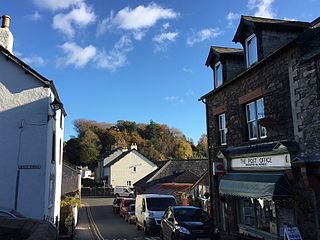
Broughton in Furness is a market town in the civil parish of Broughton West in the Westmorland and Furness district of Cumbria, England. It had a population of 529 at the 2011 Census. It is located on the south western boundary of England's Lake District National Park, and in the Furness region, which was historically part of Lancashire.

Belstead is a village and civil parish in the Babergh district of the English county of Suffolk. Located on the southern edge of Ipswich, around 3 miles (5 km) south-west of Ipswich town centre. It had a population of 202 according to the 2011 census. Belstead has amenities such as a village hall, St Mary's the Virgin Church, The bridge school for children with learning difficulties and Belstead Brook Hotel and Spa. It is in the Belstead Brook electoral division of Suffolk County Council.
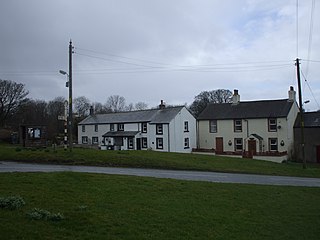
Bothel and Threapland is a civil parish in Cumbria, England, just outside the Lake District National Park. According to the 2001 census, it had a population of 438. The parish includes the villages of Bothel and Threapland. The village of Bothel is south-east of the parish of Aspatria and Threapland is south of Aspatria and Carlisle is eighteen miles (29 km) North-east of the parish. It had a population of 483 in the 2011 census figures.

Gosforth is a village, civil parish and electoral ward in the Lake District, in Cumberland, England. It is situated on the A595 road between Whitehaven and Barrow-in-Furness. It had a population of 1,230 at the 2001 Census. At the 2011 census Gosforth was grouped with Ponsonby and Wasdale giving a total population of 1,396.

Seascale is a village and civil parish on the Irish Sea coast of Cumbria, England, historically within Cumberland. The parish had a population of 1,754 in 2011, barely decreasing by 0.4% in 2021.

Beckermet is a village and civil parish in Cumbria, England, between Egremont and Seascale. The parish had a population of 1,619 in the 2011 census.

Hensingham is a suburb of Whitehaven and former civil parish, now in the parish of Whitehaven, in the Cumberland district, in the ceremonial county of Cumbria, England. The ward population taken at the 2011 census was 4,145.

Irthington is a village and civil parish within the Cumberland district in Cumbria, England, situated to the north-east of Carlisle Lake District Airport. The population in 2011 was 860 according to the 2011 census.

Moor Row is a village in Cumbria, North West England. It is in Egremont civil parish and lies on a minor road off the A595, south-east of Whitehaven. In 2018 it had an estimated population of 759.

Gilcrux is a small village and civil parish in the ceremonial county of Cumbria, England, and historically part of Cumberland. It is situated just outside the Lake District National Park.
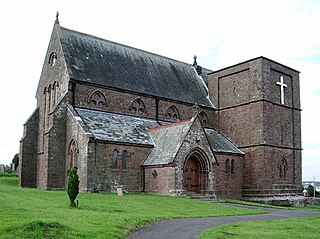
Distington is a large village and civil parish in Cumbria, England, 3 miles (4.8 km) south of Workington and 4 miles (6.4 km) north of Whitehaven. Historically a part of Cumberland, the civil parish includes the nearby settlements of Common End, Gilgarran and Pica. The parish had a population of 2,247 in the 2001 census, increasing slightly to 2,256 at the 2011 census.

Calder Bridge is a small village in Cumbria in England. It is located between the hamlets of Gosforth and Beckermet and lies on the River Calder.

Stainton is a village and civil parish in the Westmorland and Furness district of Cumbria, England. It is near the village of Sedgwick and 5.3 miles (8.5 km) south Kendal. Killington Reservoir runs alongside the parish of Stainton and the village is near the A590 road. In 2021 the parish had a population of 316. From 1974 to 2023 it was in South Lakeland district.

Haile is a small village and civil parish in Cumberland district, in the county of Cumbria, England. It had a population of 617 at the 2011 census.

Cookley is a small village and civil parish in the East Suffolk district, in the east of the county of Suffolk, England. Nearby settlements include the town of Halesworth and the village of Walpole. The village includes the church, cottages and a farm that follows the stream which joins the Blyth River at the town of Halesworth. The church and houses are on the rising ground to the North of the stream.
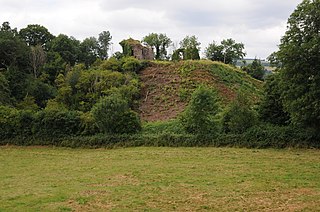
Clifford is a village and civil parish in Herefordshire, England, and 2.5 miles (4.0 km) to the north of Hay-on-Wye. It lies on the south bank of the River Wye, which here forms the border between Wales and England. The village sits on the B4350 road. The civil parish includes the hamlets of Priory Wood and Hardwicke.

Mirehouse is an area and ward in the English county of Cumbria and within the boundaries of the historic county of Cumberland. Mirehouse is 1.5 miles south of the town of Whitehaven near the A595 road. Mirehouse Estate, locally colloquially known as ‘The Valley’. The West was referred to 09 side and the East as 07 side, taken from the numbers of the bus routes that served them. The ward was 5,481 at the 2021 census.


























